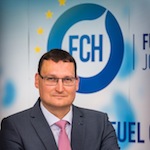
Solutions for a hydrogen economy, from ‘valleys’ to islands
Technological breakthroughs have put hydrogen firmly at the heart of the European Green Deal. What is sometimes missing is the big picture of its place in a smart low-carbon economy built on smart energy integration. Hydrogen valleys address this lack, offering insights into how the puzzle might fit together and meet communities’ needs.
Hydrogen is a priority in the EU’s Green Deal proposal. The transition to a carbon-neutral society by 2050 requires a major shift in how our society and economies operate, switching to renewable energy sources, greening industry and shifting to a low-waste, circular economy.
Fuel cell and hydrogen (FCH) technologies offer solutions to these challenges, and more. For example, hydrogen buses and ferries are currently being used in our cities and island regions, while “green” hydrogen from renewable sources is becoming more affordable, more accessible and more sustainable.
Here at the FCH JU, we are taking these innovations a step further by promoting hydrogen valleys to demonstrate how a hydrogen-based economy could work.
We coined the term “hydrogen valleys” in 2019 to describe self-contained areas which are in various stages of developing hydrogen technology to achieve sectoral integration.
These do not have to be valleys in the geographic sense. However, the integration of hydrogen technologies is typically made in a limited area, such as an island, city, region or industrial cluster, hence their other common name of “hydrogen territories”.
The most complete hydrogen valleys cover the whole hydrogen supply chain, from production to final use, and a range of impacted sectors, such as manufacturing, mobility and energy storage.
Compared to reviews of individual applications, a large-scale integrated system provides clearer insight into how to develop a hydrogen economy. And because the areas consume large amounts of hydrogen, costs are also typically lower, and more realistic.
In short, we see the development of hydrogen valleys as an important step in scaling up hydrogen-based technology and making it a viable part of the greener economy so vital to our future.
A growing trend
The complexity and cost of a hydrogen valley might seem daunting to planners. It is therefore reassuring to know that countries and regions are already adopting the concept.
In Germany, the national government is supporting regions and municipalities in their adoption of hydrogen and fuel cell technology to decarbonise economies, its “HyLand” concept. It speaks volumes that one of Europe’s most successful economies is already pushing ahead with hydrogen.
In France, a “Zero Emission Valley” is being developed around Chambery and Aix-les- Bains, piloting a larger plan to decarbonise the Auvergne-Rhône-Alpes region.
Europe’s largest-scale hydrogen valley is in the Northern Netherlands, funded in part by the FCH-JU. In 2019, we held our first hydrogen valley call and awarded €20 million – our largest ever single grant – to the HEAVENN project, which combines over 60 hydrogen projects across the region. The funding complements a €70 million contribution from industry and other organisations worldwide, indicating the scale of the project and its importance.
People-focused regeneration
Hydrogen can also be a game-changer in islands, driving locally led green regeneration. Because of their remoteness and climate, islands often have unreliable, expensive energy supplies. Economic factors complicate matters as demand surges in the tourism season then falls sharply later in the year.
Hydrogen can help to balance the local energy system, boost growth and — as the current pandemic makes all too immediate — strengthen resilience to economic shocks.
For example, the BIG HIT project in the Orkney Islands in the north of Scotland, to which we contributed, has expanded the islands’ low-carbon economy and boosted incomes.
Local communities guided partners on how to step up their existing use of hydrogen to manage the high levels of energy the islanders produce from wind, waves and tides.
Excess energy now splits locally sourced water into hydrogen to heat two schools and supply fuel cells powering a harbour area, ferries and small fleet of fuel-cell vehicles.
A trading and distribution model completes the strongly replicable project, which won third place in the 2019 EU RESPonsible Island Prize.
Another island, Martinique in the West Indies, illustrates hydrogen’s value for a more circular economy. The ClearGen project, is recovering waste hydrogen from the islands’ oil refinery to power a 1 MW large-scale fuel cell. This increases islanders’ electricity supply with no increase in CO2 emissions and keeps production costs low, essential in a community vulnerable to climate change and with modest average incomes.
New project support
With these successes in mind, the FCH-JU has focused its 2020 call for applications for funding on projects for hydrogen islands. We will foster bottom-up initiatives supported by targeted programmes and guidance to develop more sustainable communities. The winner will be announced by the end of July 2020.
We are also bringing information for projects under one roof – our new hydrogen valley website. The platform will provide an overview of leading hydrogen projects, offer support ranging from best practice information to a business case tool, and contact with other hydrogen initiatives for advice.
Hydrogen valleys are important for the climate, economy and our energy security. Join us in shaping the hydrogen economy.




